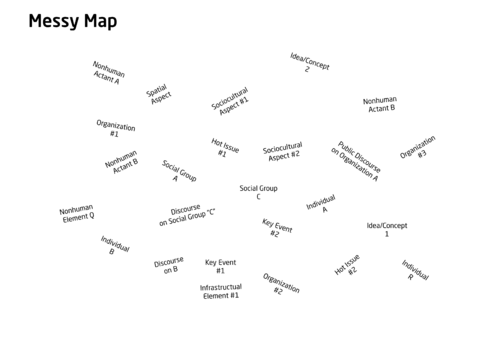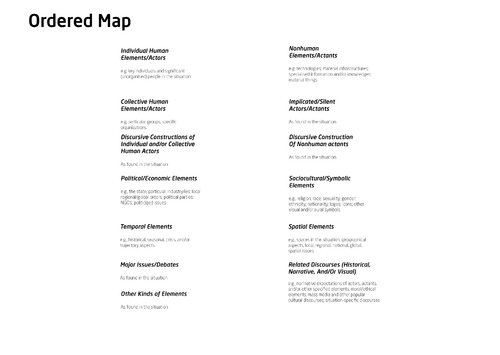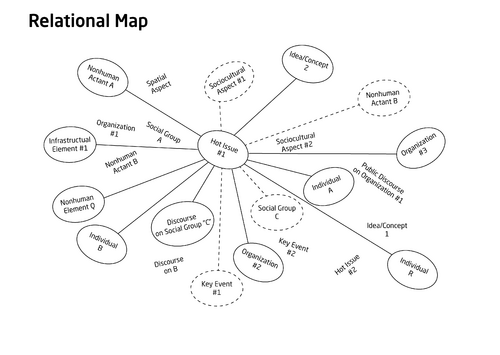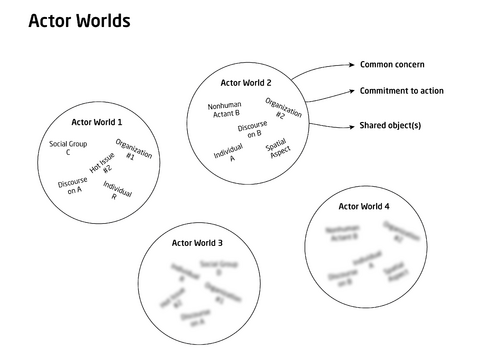Situational mapping
Contents |
Abstract
Whenever a project or program is conducted it is oftentimes with the intention of changing the status quo of the current situation. It is therefore not so irrelevant to know what the situation is and what impact the offered change (a so-called translation) in the status quo will have on the situation. Any given situation consists (for the most parts) of the same elements; human and non-human, material and symbolic/discursive elements as framed by those in it and the analyst [1]. The "human" element is everything human related and can in relation to PPPM best be described as "stakeholders". Knowing stakeholders and their relation to the situation is important but to understand all elements of the situation is even more important. By knowing the other elements of the situation a project/program manager can mitigate even more risks and uncertainties that are dwelling in the complexity of their activities.
Situational mapping is an analytical tool and a prerequisite to another situational analysis tool Development Arena[1], when used can give a better understanding of the situation the project or program is trying to change. Situational mapping consists of three different maps; Messy map, Ordered map and Relation map. The maps are worked can be worked with in a chronological order with the last being the relational map or all three maps can be worked with simultaniously, if the time frame allows for greater abstraction. As one goes through the steps of analyising the situation with the three maps the important aspects becomes clearer and subsequently the different actors "human" or "non human" each with their unique relationship to eachother or maybe the same "common concern", "commitment to action" or "shared objects" will form based on these three into "Actor Worlds"and then eventually they will start to populate the Development Arena.
Situational mapping can be seen as an advanced stakeholder analysis where not only the stakeholders are populating the arena but literally everything else that can have a sizeable impact on the project or program is mapped and accounted for.
Introduction
Prior to delving into the methods of situational mapping, it is imperative to know and understand how the method came to be, as this establish the basis for the acknowledgement of the tool.
Situational mapping is a situational analysis (SA) tool developed by the American sociologist Adele E. Clarke as an extension of another socioligical analysis theory called "Grounded Theory" (GT). GT was developed by Barney Glaser and Anselm Strauss’ back in 1967, when they published "The discovery of grounded theory: strategies for qualitative research". It is possible, that some may already know, that GT is a qualitative social research methodolgy that can be accomodated when trying to understand and analyse imperical data. The method uses the inductive reasoning framework, which seeks to formulate a theory based on the actual data rather than having a set of theories and models fit the data (deductive reasoning). Theory that blossoms from the collected data is more likely to be true and look like the real world, compared to theory that stems from experiences and speculations of how one believes things should be. Adele E. Clarke was a student of the two and had therefore worked with GT for a long period of time before she in 2005 published the book: "Situational Analysis: Grounded theory after the Postmodern Turn".
In her book Adele E. Clarke put forwards three main situational maps; "Situational maps", "Social Worlds/arenas maps" and "Positional maps" (the lather being a strategy for plotting positions articulated and not articulated in discourses, which is not covered in this article). With these, she articulates a different way of codifying the imperical data which instead becomes much more visual drawing parallels to another theoretical framework used in qualitative researh, namely Actor-network theory (ANT) (ref Latour and Callon). Although, these two framework come very close to describing many of the same elements and mechanism in a social context, the difference lies in the nature of the focus and scope of the analysis. While SA seeks to develop a theory of the social context, ANT is more concerned with the broader view of the creation and maintenance of socio-technical networks. In the context of project, program and portfolio management, it is relevant to set aside their differences, as these are mainly rooted in the originating field of study and not so much of the practicalities of the methodology.
In reality, it becomes even clearer to what extend the two line of thoughts cross paths with eachother, when Clarke mentions the notion of Social worlds/Arenas maps as the second "situational map". Evidently, the construction of Social worlds and Arenas maps is closely linked to the theories of Actor Worlds and Development Arenas articulated in ANT, giving te founding theories, being GT and ANT their spatial aspect respectively.
(missing some elements!!!)
In the following section, the methods of Situatinal mapping is described.
Situational maps - a precursor for the Development Arena
As it is reasoned in the introduction, the SA framework of situational mapping can be used together with the Development Arena framework to gain a more comprehensive understanding of a complex social situation. Situational mapping provides the necessary starting point for analysing the situation, while the development arena only then can provide the broader framework for understanding the context of the elements in which that situation is taking place.
- Messy Map
- Ordered Map
- Relational Map
- Actor Worlds
Situatinal Mapping Part 1: Messy Map

The messy map is the first part of the situational mapping tool (see fig. 1). With the messy map every conceivable thing related to the situation can be put down in a "messy" kind of fasion.
- The messy map seeks to cover in detail what the given situation entails.
- Who are the main human actors; - individually, social groups, organisations etc.
- What are the nonhuman actors; Technology, Weather, infrastructure, material things
- What are the discourses; discourses within social groups, organisation or even society
- What are the major issues; related to the situation
- What are the sociocultural or symbolic elements; religion, race, gender, sexuality etc.
- What are the spatial elements; geographical aspects, local, regional, national, global etc.
- The messy map can be iterated upon until it feels saturated. From one map-iteration to another, different elements can become obsolete and others can become more important.
Situatinal Mapping Part 2: Ordered Map

The ordered map (see fig. 2) is the second map in the analysis. The ordered map is made using the data from the messy map. The intention with this map is to order the findings in the analysis as the "messy map" can be quite eerie to look at as it expands and become more complex. The way one structe and order the elements from the "messy map" is up to oneself but it might be a good starting point to order them into the categories seen in fig. 2 as one gets acquainted with the methods and the tool. There is however, not an absolute need to have all of these categories in any given situation and one may even have other categories. The goal is not to fill in the blanks, but to instead really examine the given situation thoroughly, and thus making the "Ordered Map" is not an essentiel step to understand the situation and can in some cases be skipped completely and the analyst can move straight to the next map, being the relational map (see fig. 3).
Another and often used approach is the continuos iterative approach where the ordered map serves as the prelimenary map to the "Actor Worlds" where the elements from the "messy map" is directly ordered into spaces of where they belong.
Situatinal Mapping Part 3: Relation Map

The relational map is the third map in the analysis (see fig. 3). When the "messy map" is as saturated as required and picture the situation as a hollistic entity, the anlysist can start to analyse the relation between each element on the "messy map", drawing lines between them and describing "the nature" of that line. The analyst does this systematically one element at a time, using as many "relational maps" as seems useful to diagram through this analytical exercise. In reality, this part of the "situational mapping" is where the majority of the work is done, once it is constructed (ref).
To suit the needs of the analyst the relational analysis can be done very informally and personalised. One might consider to use different style of lines, colours or even symbols (squares, triangles, bolts, hearts, stars etc.) to describe key relationships between one element and another.
Situatinal Mapping Part 4: Actor Worlds - "bridging Situational Mapping and Development Arenas"

To bridge the theory from Situational mapping and Development Arenas, the concept of actor worlds or social worlds as Adele E. Clarke frames it, becomes the underlying foundation for this, as it these that populate the development arena. The two concepts are used interchangeably to describe the following; An actor-world is an analytical social construct, meaning that in reality they do not exist. They consists of actors, non-human actors and groups of actors such as organisations. The discourses, related to single actors or a group of actors, are what define the boundaries of these actor worlds. In theory, the actor worlds are constituted around a particular common concern, which in turn yields the momentum for actors and group of actors to form alliances with each other and objects, hereby having the same commitment to action and shared objects to hereby adress the common concern. An actor world always consists of these three elements and it is what distinguish one actor world from another, however one actor world can unanimously share one or even two (but not all three!) of these elements with a different actor world. If they share all three, their is no arguement for why they couldn't be the same actor world.
Situational mapping as a PPPM tool
The soul purpose for why this article has a part on this wiki site, is because it is reasoned and argued for that the tool of situational mapping can serve as a critical tool in project, program and portfolio management. This section will disccuss the applicability for pppm's and why it could potentially leverage their management of either of these.
Application
Discussion
Although situational mapping can be a useful tool for project, program and portfolio managers, there of course some limitations to consider.
Limitations
- Time and resource-intensive: Situational mapping can be a time and resource-intensive tool for managers to use, because it often requires a significant investment in data collection and the anlysis thereof. This could impose a challenge for many project managers, as they are often under a tight timeline and budget.
- Insufficient generalisability: What is found in the analysis of Situational mapping is often specific to certain context, meaning that it may not be generalisable to other contexts. In truth, this can limit the practicality of the tool for project, program and portfolio managers, as they perhaps work across a variety of projects and contexts.
- Subjectivity: Situational mapping is a qualitive analysis tool relying on the perspective and experiences of individuals. As such is is a subject to bias, and may therefore not provide a completely objective view of the situation.
- Overwhelming amount of data: The amount of data generated of situational mapping can be overwhelming, making it dificult for project, program and portfolio managers to priorities and act upon the most important and relevant findings.
The tools relation to the four core pratices or perspectives of PPPM: "Purpose, People, Complexity and Ucertainty"
Situational mapping can be used by project, program and portfolio managers in adressing the four core practices of project management by providing an increased insight in the social context of each of their domain. And although it can be used as a seperate tool, the relation to four perspectives, shall in this case also be understood as it's contribution to the Development Arena, for which the relation to PPPM is inherently more clear. The contribution of situational mapping to each of these perspectives is desribed here:
Purpose: For the purpose perspective, Situational mapping provide key information about a range of different aspects and elements related to the situation. Some of these relates to the controversies or hot issues as they are described in the theory or maybe former important translations resulting in large displacements of some of the actors or actor worlds. Typically the PPPM wish to change or maybe even keep the sitation as is, which effectively will have an impact on the situation and it's actor worlds. By knowing these elements and insights of the social context, the chance of defining the right purpose and developing the correct understanding of what needs to be achieved has become increasingly more clear.
People: For the people perspective, Situational mapping can help identify important information about key stakeholders and stakeholders not initially accounted for, for which the tool shows its true strength and purpose. By conciosly analysing discourses, historical events, controversies and translations related to these actors, the PPPM can enhance its understanding of their different perspective and experiences. This will help the PPPM to manage its stakeholders both internally and externally out side of its organisation building better relationships and unnderstanding their needs and engagement to the project, program or portfolio.
Complexity: For the complexity perspective, Situational mapping can relieve managers in understanding the different aspects of the situation, whether that will be social, cultural, historical, technological, politcal etc, which in turn will have an effect of the success and outcome of the project, program or portfolio. Subsequently, better strategies for dealing with the complexity can be developed even before they either become a threat, that needs to be dealt with.
Uncertainty: For the uncertainty perspective, Situational mapping can be a vital organ when dealing with uncertainties. The reason being, that the increased understanding of the project, program or portfolio context, that the tool provide, helps managers to identify the uncertainties, so that they can in a timely manner manage them and adapt to any changing circumstances.
Concluding remarks
This article has introduced the reader to methods of situational mapping, a situatinal analysis framework for understanding complex sociol contexts, developed by the american sociologist Adele E. Clark as an extension of Grounded theory. It also depicts the concept as a tool that when used in practice in a project, program or portfolio related context can act as the precursive analysis tool for the development arena.
Annotated bibliography
It is suggested to read the following litterature below to gain an even better understanding of the theory and its use in practice.
- Glaser, B. G., & Strauss, A. L. (1967). The discovery of grounded theory: Strategies for qualitative research. New York, NY: Aldine De Gruyter.
- Jørgensen, U. & Sørensen, O. (1999) Arenas of Development - A Space populated by Actor-Worlds, Artefacts and Surprises
- Clark, A. (2005). Doing Situational Maps and Analysis - Situational Analysis: Grounded Theory after the Postmodern Turn. Thousand Oaks, CA: Sage.
- Clark, A. & Star, S. (2008).The social worlds framework: a theory-methods package . - The New Handbook of Science and Technology Studies
- Clark, A., Washburn, R. & Friese, C (2022). Situational analysis in practice : mapping relationalities across disciplines
References
- ↑ Adele E. Clark (2005).Doing Situational Maps and Analysis. Chapter in "Situational Analysis: Grounded Theory after the Postmodern Turn", Thousands Oak Sage: page 83-144
- ↑ Adele E. Clark (2005).Doing Situational Maps and Analysis. Chapter in "Situational Analysis: Grounded Theory after the Postmodern Turn", Thousands Oak Sage: page 83-144
- ↑ Adele E. Clark (2005).Doing Situational Maps and Analysis. Chapter in "Situational Analysis: Grounded Theory after the Postmodern Turn", Thousands Oak Sage: page 83-144
- ↑ Adele E. Clark (2005).Doing Situational Maps and Analysis. Chapter in "Situational Analysis: Grounded Theory after the Postmodern Turn", Thousands Oak Sage: page 83-144
- ↑ Adele E. Clark (2005).Doing Situational Maps and Analysis. Chapter in "Situational Analysis: Grounded Theory after the Postmodern Turn", Thousands Oak Sage: page 83-144